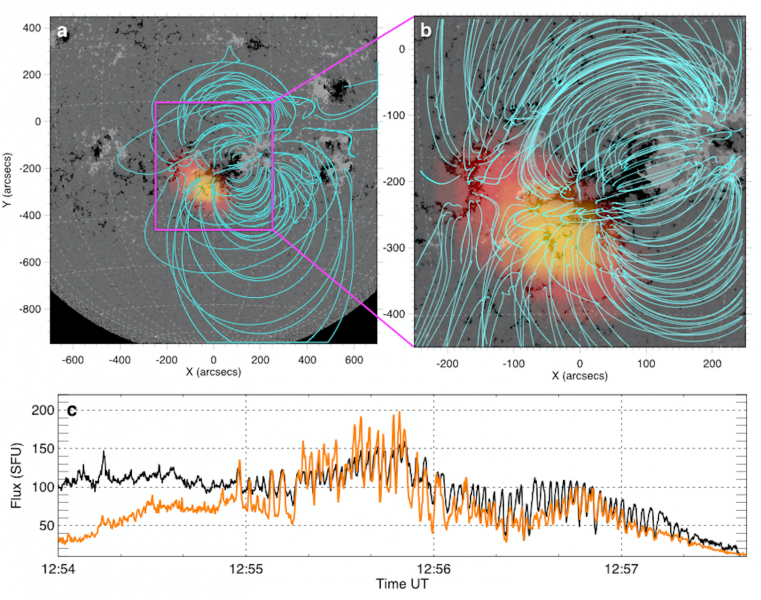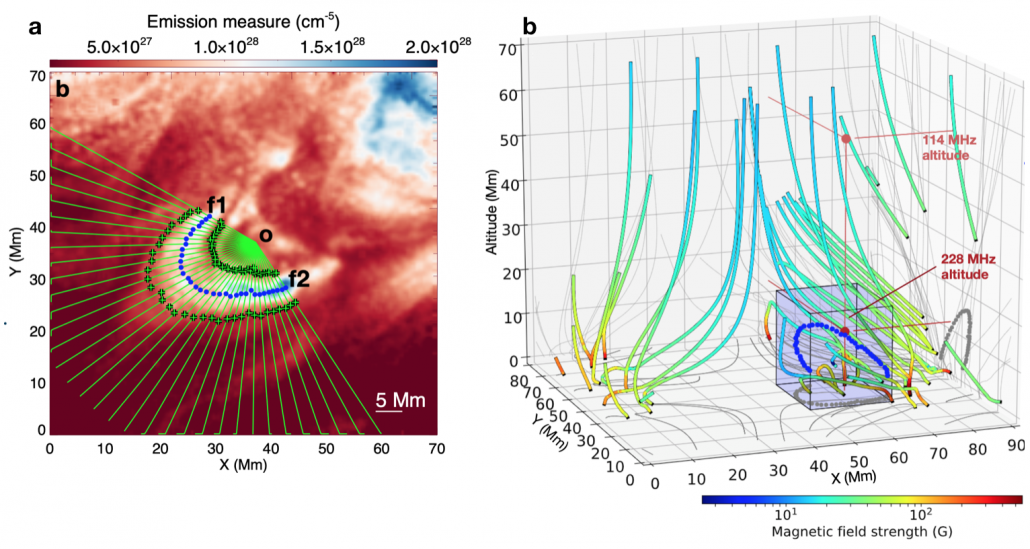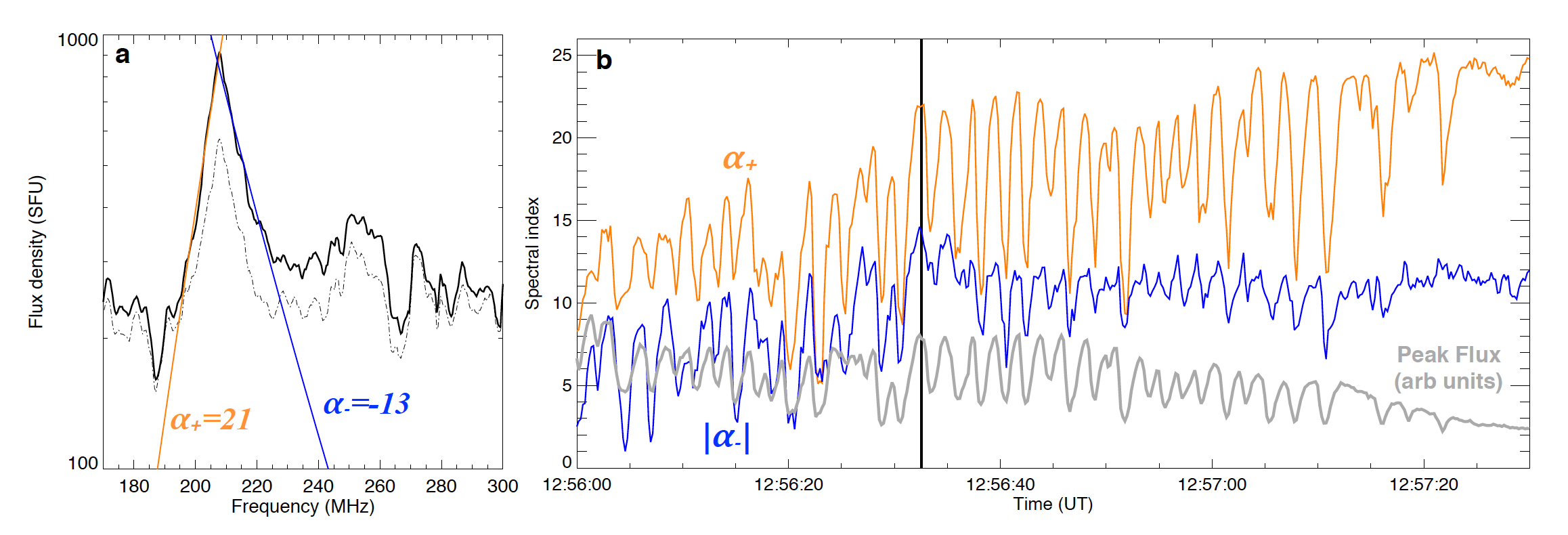Flare accelerated electrons emit light from X-rays to radio waves, which sometimes show highly regular and periodic intensity pulsations (Nakariakov et al. 2009). However, the processes that bring about these pulsations remains a hotly debated topic. The primary candidates are periodic magnetic reconnection, magnetohydrodynamic (MHD) oscillations, or some complex combination of both (Aschwanden et al. 1986, Nakariakov et al. 2006). Plasma dynamics of these processes can play out on timescales of seconds or less, so temporally resolving this behaviour in imaging observations is a modern challenge in solar physics. Here we describe the use of the Nançay Radioheliograph (NRH) to image a radio source that shows intensity pulsations with a period of 2.3 seconds. We relate this observation to a loss-cone instability modulation due to a magnetohydrodynamic sausage mode oscillation in the solar corona.
Observations
The Nançay Radioheliograph (NRH) is a dedicated solar radio interferometer located in central France, operated by the Nançay Radio Astronomy Section of the Paris Observatory. It is capable of producing low frequency, high-time resolution (0.25 seconds) imaging observations at ten discrete frequencies from 150-445 MHz. On 18th April 2014, NRH observed multiple radio sources in the vicinity of AR12036 (see Carley et al. 2016 for details). During part of the eruptive event, a secondary radio source was observed in a non-flaring region ~400 Mm east of the flare site in AR12035, see Figure 1a,b.
 Figure 1 – (a) A combination of PFSS magnetic field extrapolation and radio imaging at 228 MHz (red region) and 327 MHz (yellow region) using NRH. (b) A more detailed NLFFF modelling of the region shows the kind of magnetic topologies the radio source belonged to, taking place at magnetic footpoints of large magnetic loops in a coronal active region. (c) Light curves from both NRH (228 MHz; black) and Orfées (208 MHz; orange) revealed a steady period of 2.3 seconds over the course of approximately 3 minutes.
Figure 1 – (a) A combination of PFSS magnetic field extrapolation and radio imaging at 228 MHz (red region) and 327 MHz (yellow region) using NRH. (b) A more detailed NLFFF modelling of the region shows the kind of magnetic topologies the radio source belonged to, taking place at magnetic footpoints of large magnetic loops in a coronal active region. (c) Light curves from both NRH (228 MHz; black) and Orfées (208 MHz; orange) revealed a steady period of 2.3 seconds over the course of approximately 3 minutes.
We combined 228, 298 and 327 MHz radio images from NRH with NLFFF model for the active region magnetic field, showing that the radio source was concentrated above magnetic footpoints near the core of the active region, see Figure 1a,b. Using additional observations of the pulsations from the Orfées spectrometer at Nançay (operating from 10-1000 MHz), we were able to show the pulsations had a steady 2.3 second period over the course of ~3 minutes. Dynamic spectra of the pulsations also revealed a number of reverse drift bursts (see Figure 4 of Carley et al. 2019). This is evidence for repeated electron beam acceleration into lower altitudes of the active region. Further evidence for this repeated electron acceleration was found from a correlation between the pulsation envelope at 327 MHz and FERMI GBM 50-101 keV flux, as well as RSTN flux at 5 GHz (see Supplementary Figure 3 of Carley et al. 2019).
Magnetic field modelling at the pulsation origin
In general, pulsations appear as quasi-periodic, owing to the stochastic dynamics of the reconnection process that is believed to drive them (Aschwanden et al. 1987). However, in our case, the pulsations are highly regular, showing little (if any) signs of quasi-periodicity. A primary means by which this could happen is through the modulation of the emission through an MHD oscillation. Through a combination of AIA differential emission measure (DEM) analysis and NLFFF extrapolations using HMI (Figure 2), we were able to identify a magnetic loop near the source of the radio pulsations with a density, temperature and magnetic field strength that could host a sausage mode oscillation period of ~1.6 seconds (similar to the radio source pulsation period observed using NRH). This provided evidence that such an MHD oscillation may be involved in the pulsating radio source.

Figure 2 – (a) A detailed analysis of the radio pulsation region revealed a small loop at the pulsation origin. A DEM analysis was performed on this small loop using AIA. (b) NLFFF of the environment of this small loop determined that it could sustain a sausage mode oscillation of the order of 1.6 second and it was closely related in 3-dimensional space to the radio pulsation origin, making it a likely candidate in the origin of the pulsating radio source.
Loss cone instability modulation
While the above outlines evidence for periodic electron acceleration and the involvement of a sausage mode oscillation, the observations revealed one final and unexpected complexity. The pulsation flux density spectrum was highly peaked with very large spectral slopes of +21 and -13, see Figure 3. This is generally interpreted as electron cyclotron maser (ECM) emission that produces Langmuir waves (ECM Z-mode), and is attributed to the presence of a loss-cone instability (Benz & Tarnstrom 1976). We find that this emission intensity as well as its spectral indices are modulated, implying a modulation of the loss-cone instability that causes the emission.
 Figure 3 – (a) The flux density spectrum of a single pulsation from the Orfées spectrometer. The steep spectral indices are evidence for ECM Z-mode emission, e.g., radio emission associated with a loss-cone instability in a magnetic trap in the corona. (b) The unique aspect of this observations is that the ECM emission is modulated.
Figure 3 – (a) The flux density spectrum of a single pulsation from the Orfées spectrometer. The steep spectral indices are evidence for ECM Z-mode emission, e.g., radio emission associated with a loss-cone instability in a magnetic trap in the corona. (b) The unique aspect of this observations is that the ECM emission is modulated.
Conclusions
The observations are multi-faceted and show (i) low frequency radio observations of periodic electron acceleration at ~2.3 seconds, (ii) a small loop with physical properties that could result in a ~1.6 second period sausage mode oscillation, (iii) modulation of emission with characteristics expected of an ECM Z-mode process. We interpret this as periodic acceleration of electrons into a magnetic trap where they modulate a loss-cone instability and the associated radio emission, much the same as the mechanism previously reported in Benz & Kuijpers (1976). The periodic acceleration of electrons may be due to repeated magnetic reconnection modulated by an MHD sausage mode oscillation on a small magnetic loop near the pulsating radio source origin. This shows that radio pulsations can be due to a complex combination of periodic reconnection-driven electron acceleration and MHD oscillations in the solar corona.
Related article:
This nugget is based on Carley, E.P. et al. Nature Communications., 10, 2276 (2019)
References:
Aschwanden, M. J, Sol. Phys. 111, 113–136 (1987).
Benz, A. O. & Tarnstrom, G. L., Astrophys. J. 204, 597–603 (1976).
Benz, A. O. & Kuijpers, J., Sol. Phys. 46, Issue 2
Carley, E. P., Astrophys. J. 833, 87 (2016).
Nakariakov, V. M. & Melnikov, V. F., Space Sci. Rev. 149, 119–151 (2009).
Nakariakov, V. M. et al., Space Sci. Rev. 149, 119–151 (2009).
*Full list of authors: Carley, Eoin P.; Hayes, Laura A.; Murray, Sophie A.; Morosan, Diana E.; Shelley, Warren; Vilmer, Nicole; Gallagher, Peter T.
